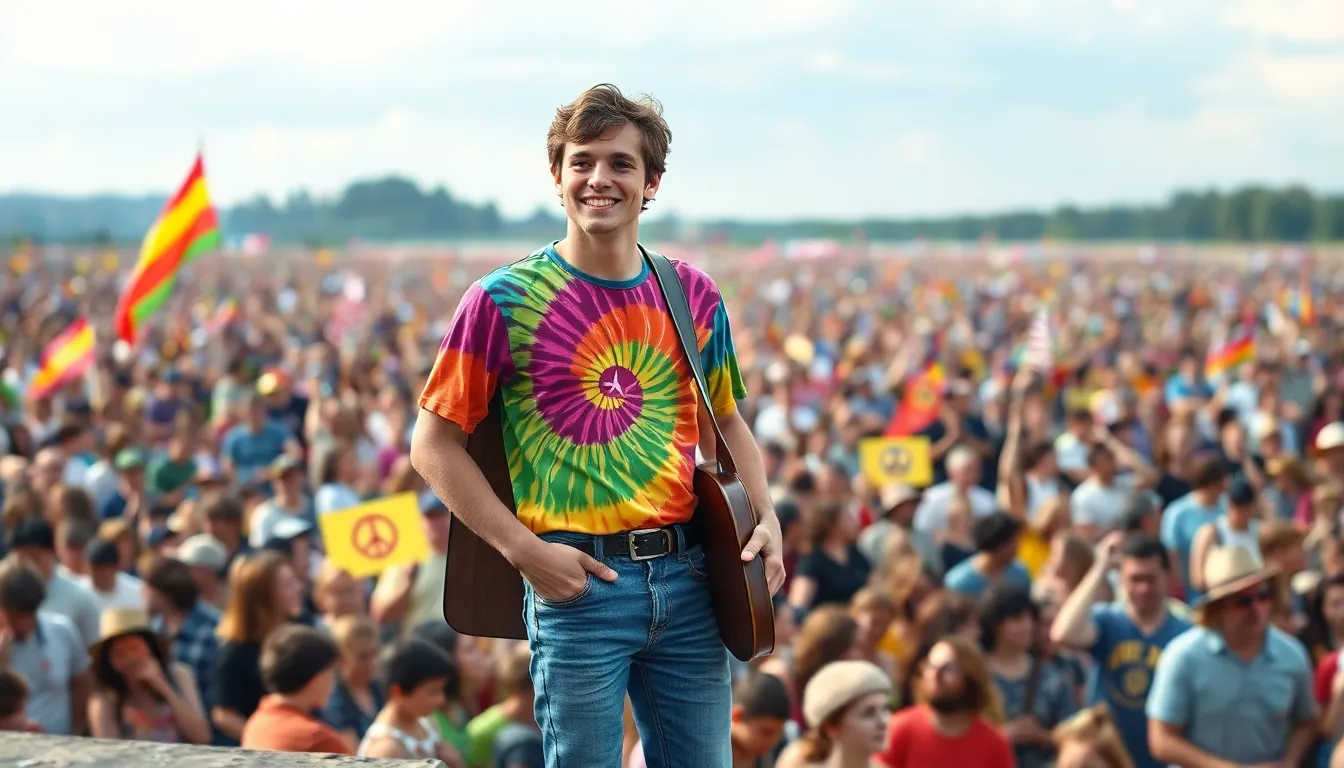The 1960s weren’t just a decade; they were a vibrant explosion of creativity, rebellion, and unforgettable style. Picture this: bell-bottoms, tie-dye shirts, and music that could make anyone want to dance like nobody’s watching. From the Beatles’ iconic melodies to the revolutionary spirit of Woodstock, the 60s redefined what it meant to be young and free.
Table of Contents
ToggleOverview Of 60s Pop Culture
The 1960s represented an explosion of creativity and cultural shifts. Popular music transformed with the rise of iconic bands and artists. The Beatles redefined music with their innovative sound and influential styles, leading the British Invasion in the United States. Artists like Jimi Hendrix and Bob Dylan pushed artistic boundaries, shaping the music landscape significantly.
Fashion during the 60s reflected a spirit of rebellion and self-expression. Bright colors, bold patterns, and unique styles emerged. Clothing items such as bell-bottoms and tie-dye shirts became symbols of youth culture. The influence of music and art extended into the fashion world, creating a distinct look that defined a generation.
Major events, including Woodstock in 1969, highlighted the era’s embrace of freedom and peace. This festival attracted nearly 400,000 attendees, emphasizing a collective desire for unity and change. The counterculture movement also gained momentum, challenging societal norms and advocating for civil rights and anti-war efforts. The combination of music festivals, political activism, and innovative artistic expressions crafted a vibrant cultural narrative.
Television played a crucial role in shaping public perception during this decade. Iconic shows such as “The Ed Sullivan Show” and “The Twilight Zone” captivated audiences, reflecting contemporary issues and emerging trends. This visual medium became a major outlet for cultural exchange, influencing the ways people connected with popular culture.
Overall, the 1960s marked a significant cultural transformation, driven by music, fashion, and significant events. Themes of rebellion, creativity, and unity emerged, creating a legacy that continues to influence contemporary culture.
Music Trends In The 60s

The 1960s marked a significant transformation in music, heavily influenced by cultural shifts and social movements. Rock and roll dominated the airwaves, shaping the decade’s identity.
The Rise Of Rock And Roll
Rock and roll experienced unprecedented growth during the 60s. Genres evolved rapidly, blending styles and inviting experimentation. New subgenres emerged, including folk rock and hard rock. This period introduced innovative techniques and progressive lyrics that resonated with youth. Songs often conveyed messages of love, peace, and rebellion, mirroring the societal changes of the era. Various festivals showcased emerging talent, reinforcing the genre’s cultural significance. Festivals like Woodstock became iconic, emphasizing music’s role in counterculture movements. Artists connected with audiences on a personal level, fostering a sense of community among fans.
Influential Artists And Bands
Numerous artists and bands defined the 60s music scene, leaving a lasting legacy. The Beatles led the British Invasion, captivating millions with their catchy melodies and dynamic performances. Bob Dylan revolutionized songwriting with powerful lyrics that spoke to the disillusionment of a generation. Jimi Hendrix transformed guitar playing, delivering explosive performances that showcased his groundbreaking techniques. The Rolling Stones brought raw energy and rebellious spirit to rock, challenging traditional norms. Motown groups introduced a new sound, blending pop and soul, making an impression across demographic lines. Each artist contributed unique elements, creating a rich tapestry of musical innovation that influenced future generations.
Fashion Styles Of The 60s
The 1960s showcased a range of distinctive fashion styles that embodied the spirit of rebellion and creativity. Influences from music and cultural shifts inspired a vibrant and diverse wardrobe.
Iconic Trends And Designers
Designers like André Courrèges and Mary Quant emerged, defining the decade with bold shapes and innovative materials. Miniskirts became a symbol of women’s liberation, while psychedelic prints and tie-dye patterns reflected the counterculture movement. Bell-bottoms gained popularity among both men and women, contributing to the era’s relaxed aesthetic. Accessories included oversized sunglasses and brightly colored handbags, adding flair to outfits. The era also saw the rise of ready-to-wear fashion, making trends more accessible to the masses.
Impact Of Fashion On Youth Culture
Fashion in the 1960s significantly influenced youth culture, fostering a sense of identity and expression. Young people embraced styles that challenged traditional norms, showcasing individuality through clothing choices. The music scene played a crucial role, with musicians setting trends that inspired fans to adopt a similar aesthetic. The festival atmosphere at events like Woodstock inspired vibrant, free-spirited fashion, reinforcing the connection between style and social movements. As a result, youth culture in this decade became synonymous with innovative self-expression through fashion choices.
Film And Television In The 60s
The 1960s produced significant shifts in film and television, marking a period of creativity and innovation.
Groundbreaking Movies And Shows
Innovative films like “Easy Rider” and “The Graduate” redefined Hollywood norms. “Citizen Kane” influenced narratives and storytelling techniques, while “Psycho” introduced suspense in a groundbreaking way. Television experienced transformation with shows like “Star Trek,” which explored social themes and included diverse casting. “The Ed Sullivan Show” showcased cultural icons, including The Beatles, bridging music with mainstream entertainment. Such programs captivated audiences and reflected societal changes, allowing fans to engage with emerging cultural movements.
The Emergence Of Counterculture In Media
Media became a platform for counterculture expression during the 1960s. Documentaries and films approached themes of social justice, anti-war sentiments, and civil rights, shaping public discourse. Series such as “The Twilight Zone” offered thought-provoking narratives that challenged viewers’ perceptions of society. Advancements in broadcasting technology allowed youth to access alternative viewpoints, fostering engagement with radical ideas. Counterculture icons utilized film and television to amplify messages of peace and rebellion, reinforcing the decade’s revolutionary spirit and connecting art with activism.
Social Movements And Changes
The 1960s experienced transformative social movements that reshaped American society.
Civil Rights Movement And Its Impact
Civil rights leaders, including Martin Luther King Jr. and Malcolm X, fought for racial equality and justice. Events such as the March on Washington in 1963 drew over 250,000 participants, showcasing the demand for civil rights legislation. Legislative milestones followed, such as the Civil Rights Act of 1964, which prohibited discrimination based on race, color, religion, sex, or national origin. This period saw organizations like the Student Nonviolent Coordinating Committee (SNCC) mobilizing youth to engage in activism. Cultural expressions reflected this movement, with music and art amplifying messages of hope and equality.
The Role Of The Vietnam War In Shaping Culture
The Vietnam War ignited widespread protest across the United States, influencing not only political views but also cultural expressions. Anti-war demonstrations attracted thousands of participants, creating a powerful narrative against military intervention. Music played a key role, with songs like “Fortunate Son” by Creedence Clearwater Revival and “Give Peace A Chance” by John Lennon becoming anthems for the peace movement. Additionally, graphic images from the frontlines reached living rooms via television, altering public perception significantly. This conflict stirred debates surrounding authority and challenged the status quo, fostering a landscape of dissent that resonated throughout the decade.
The 1960s stand as a remarkable era that reshaped the cultural landscape in profound ways. With its vibrant music scene fashion revolutions and groundbreaking media innovations it fostered a spirit of rebellion and creativity. The decade’s influential figures and movements not only challenged societal norms but also inspired generations to come. As the echoes of Woodstock and the Civil Rights Movement resonate today it’s clear that the legacy of the 60s continues to influence contemporary culture. This dynamic period remains a testament to the power of art and activism in driving social change and fostering a sense of community.










